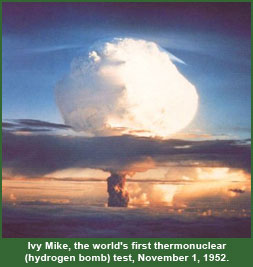
Time Periods
1890s-1939:
Atomic Discoveries
1939-1942:
Early
Government Support
1942-1944:
The Uranium
Path to
the Bomb
1942-1944:
The Plutonium
Path to
the Bomb
|
Early work on the
design of the atomic bomb began even as
scientists continued to arrive at
Los Alamos
throughout 1943. The
properties of uranium were reasonably
well understood, those of plutonium less
so, and knowledge of fission
explosions entirely theoretical.
That 2.2 secondary neutrons were produced when uranium-235
fissioned was accepted, but while
Glenn Seaborg's team had proven in March
1941 that plutonium underwent
neutron-induced fission, it was not known
yet if plutonium released secondary neutrons during
bombardment. Further, the exact sizes of the
"cross sections" of various fissionable
substances had yet to be determined in experiments using
the various particle accelerators then
being shipped to Los Alamos. The theoretical
consensus was that fission
Sources and notes for this page. The text for this page was adapted from, and portions were taken directly from the Office of History and Heritage Resources publication: F. G. Gosling, The Manhattan Project: Making the Atomic Bomb (DOE/MA-0001; Washington: History Division, Department of Energy, January 1999), 38-39. The photograph of "Little Boy" is courtesy the U.S. Army Corps of Engineers (via the National Archives). The fission chain graphic is adapted from graphics originally produced by the Washington State Department of Health; the modifications are original to the Department of Energy's Office of History and Heritage Resources. The sketches of the gun-type and implosion approaches to bomb design are reproduced from Robert Serber's April 1943 "Los Alamos Primer," 21-22. The photograph of the "Ivy Mike" hydrogen bomb test is courtesy the Department of Energy's Nevada Site Office.
Home |
History Office
|
OpenNet
|
DOE
|
Privacy and Security Notices |


 In addition to calculations on uranium and plutonium
fission, chain reactions, and critical and effective
masses, work needed to be done on the ordnance aspects of
the bomb, or the "Gadget" as it came to be known.
Two subcritical masses of fissionable material would have
to come together to form a supercritical mass for an
explosion to occur. Furthermore, they had to come
together in a precise manner and at high speed.
Measures also had to be taken to ensure that the highly
unstable subcritical masses did not predetonate because of
spontaneously emitted neutrons or neutrons produced by
alpha particles reacting with lightweight
impurities. The chances of predetonation could be
reduced by purification of the fissionable material and by
using a high-speed firing system capable of achieving
velocities of 3,000 feet per second. A conventional
artillery method of firing one subcritical mass into the
other (above) was under consideration for uranium-235, but
this method would work for plutonium only if absolute
purification of plutonium could be achieved.
In addition to calculations on uranium and plutonium
fission, chain reactions, and critical and effective
masses, work needed to be done on the ordnance aspects of
the bomb, or the "Gadget" as it came to be known.
Two subcritical masses of fissionable material would have
to come together to form a supercritical mass for an
explosion to occur. Furthermore, they had to come
together in a precise manner and at high speed.
Measures also had to be taken to ensure that the highly
unstable subcritical masses did not predetonate because of
spontaneously emitted neutrons or neutrons produced by
alpha particles reacting with lightweight
impurities. The chances of predetonation could be
reduced by purification of the fissionable material and by
using a high-speed firing system capable of achieving
velocities of 3,000 feet per second. A conventional
artillery method of firing one subcritical mass into the
other (above) was under consideration for uranium-235, but
this method would work for plutonium only if absolute
purification of plutonium could be achieved. A
A

